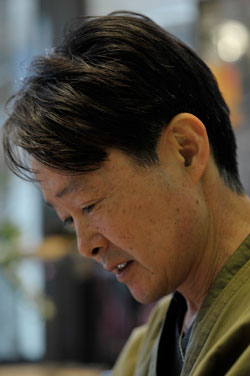Ginsen Izumi Ken Profile
Ginsen Aasakusa, silver, jewelry, traditional craft, edo
Profile
Ken Izumi
Traditional craftsman
Metalworking instructor at Bunka Gakuin, 12 years
Member of NIPPON CHOKINKAI(Japan Metalworking Academy)
Director at the Tokyo Gink (Silverware Industry Association)


Resume
| 1954 | Born in Yokohama |
| 1976 | Graduated from Bunka Gakuin |
| 1977-78 | Travels throughout Japan |
| 1979 | Hired by Shirogane Co., Ltd. |
| 1981-83 | Tokyo Silverware New Works Competition Good Effort Award Gold Medal Tokyo Governor's Award Tokyo Metropolitan Labor Bureau Chief Award |
| 1984-85 | Nipporen Zenkoku Toitsu Sakuhin Competition Nipporen Committee Award Small & Medium-sized Business Agency Award Tokyo Chamber of Commerce Award |
| 1988-91 | JJA Jewelry Contest, Crafts Division Yamanashi Prefectural Governor's Award Labor Minister's Award |
| 1993 | Resigns from Shirogane Co., Ltd. *Establishes business following study tour of Italy and Scandinavia |
| 1995-2001 | Certified for Traditional Japanese Metalcrafts Exhibition National Gold and Silver Exhibition -Receives World Gold Council Award -Receives Traditional Crafts Promotion Association Chairman's Award |
| 2005 | Establishes Ginsen Izumi Ken as a retail store, workshop, and classroom in Asakusa |
History of silverware
It is assumed that many years ago Asian nomads on horses relied on metal for their migratory life because it was durable. The manufacturing technology they developed arrived in Japan during the Nara Era, and silverware from that time is exhibited in the Shosoin Archives. Later, silver was used for the Imperial Family's utensils as well as ornaments on weapons during the Warring States Era. Moreover, bronze alloys unique to Japan were created through the mixing of gold and copper.
The use of silver spread to the general population during the latter part of the Genroku period of the Edo Era. People of higher station ordered craftsmen to make chopsticks, pill cases, and pipes. Silverware became common items for city dwellers.
After the start of the Meiji Era, the authorities ordered all swords destroyed. Craftsmen who used to decorate swords took advantage of traditional techniques to make patterned vases, 3-dimensional displays of people in seasonal settings, and Western style accessories.
This silverware was exhibited at international exhibitions and became highly regarded worldwide.
After World War II, Americans with the Occupation brought large amounts of silverware as souvenirs back to the U.S. Many strap-like accessories were mass produced and sold, as well as utensils, spice containers, candle holders, etc., thus leading to the growth of the present Tokyo Ginki(silverware industry).